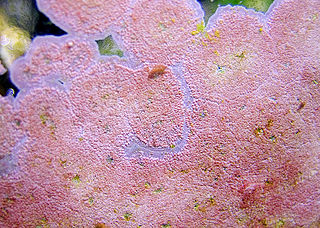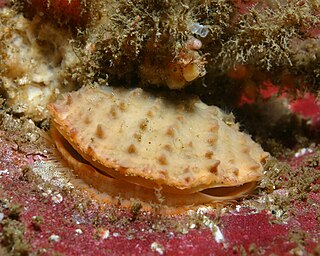
Chitons are marine molluscs of varying size in the class Polyplacophora, formerly known as Amphineura. About 940 extant and 430 fossil species are recognized.

Coralline algae are red algae in the order Corallinales. They are characterized by a thallus that is hard because of calcareous deposits contained within the cell walls. The colors of these algae are most typically pink, or some other shade of red, but some species can be purple, yellow, blue, white, or gray-green. Coralline algae play an important role in the ecology of coral reefs. Sea urchins, parrot fish, and limpets and chitons feed on coralline algae. In the temperate Mediterranean Sea, coralline algae are the main builders of a typical algal reef, the Coralligène ("coralligenous"). Many are typically encrusting and rock-like, found in marine waters all over the world. Only one species lives in freshwater. Unattached specimens may form relatively smooth compact balls to warty or fruticose thalli.

The gumboot chiton, also known as the giant western fiery chiton or giant Pacific chiton, is the largest of the chitons, growing to 36 cm (14 in) and capable of reaching a weight of more than 2 kg (4.4 lb). It is found along the shores of the northern Pacific Ocean from Central California to Alaska, across the Aleutian Islands to the Kamchatka Peninsula and south to Japan. It inhabits the lower intertidal and subtidal zones of rocky coastlines. The gumboot chiton's appearance has led some tidepoolers to refer to it, fondly, as the "wandering meatloaf". The name "gumboot chiton" seems to derive from a resemblance to part of a rubber Wellington boot or "gum rubber" boot.

Chiton glaucus, common name the green chiton or the blue green chiton, is a species of chiton, a marine polyplacophoran mollusk in the family Chitonidae, the typical chitons. It is the most common chiton species in New Zealand. Chiton glaucus is part of a very primitive group of mollusc with evidence of being present in up to 80 million years of the fossil record.

Tonicella undocaerulea, commonly known as the blue lined chiton, is a species of chiton.

Mopalia spectabilis, commonly known as the red-flecked mopalia, is a species of chiton.

Tonicella lokii, commonly known as the flame lined chiton or Loki's chiton, is a chiton in the lined chiton genus Tonicella.

Mopalia muscosa, the mossy chiton, is a species of chiton, a polyplacophoran, an eight-plated marine mollusk. It is a northeastern Pacific species which occurs from British Columbia, Canada, to Baja California Mexico.

Macoma nasuta, commonly known as the bent-nosed clam, is a species of bivalve found along the Pacific Ocean coast of North America. It is about 6 cm (2.4 in) long. It is often found buried in sands of 10–20 cm (3.9–7.9 in) in depth. This rounded clam has no radial ribs. Archaeological data supports the use of this species by Native Americans such as the Chumash peoples of central California.

Urticina crassicornis, commonly known as the mottled anemone, the painted anemone or the Christmas anemone, is a large and common intertidal and subtidal species of sea anemone. Its habitat includes a large portion of the coastal areas of the northern hemisphere, mainly polar regions, and it lives a solitary life for up to 80 years. Mottled anemones are similar to Dahlia anemones and both are commonly referred to as northern red anemones.

Mopalia hindsii is a species of medium-sized chiton that grows up to 7 cm long. Most commonly found in intertidal zones, M. hindsii has a white ventral side unlike most intertidal chitons that are orange underneath.

Cryptolithodes sitchensis, known as the umbrella crab, is a species of lithodid crustacean native to coastal regions of the northeastern Pacific Ocean, ranging from Sitka, Alaska to Point Loma, California. Its carapace extends over its legs such that when it pulls in its legs, it resembles a small stone. It lives in rocky areas from the low intertidal to depths of 17 m (56 ft).

Mopalia ciliata is a chiton in the genus Mopalia, commonly known as the hairy chiton. It is a medium-sized marine mollusc up to 5.0 cm (2.0 in) in length. It is oval shaped with 8 separate, moderately elevated, overlapping ridged valves on its dorsal surface. Hairy chitons can be found along the coast of North America.

Katharina tunicata is commonly known as the black Katy chiton, black Leather chiton, black chiton, or leather chiton,, is a species of chiton in the family Mopaliidae.

Crassadoma is a genus of rock scallops, marine bivalve molluscs in the family Pectinidae. It is monotypic, the only species being Crassadoma gigantea, the rock scallop, giant rock scallop or purple-hinge rock scallop. Although the small juveniles are free-swimming, they soon become sessile, and are cemented to the substrate. These scallops occur in the eastern Pacific Ocean.

Plaxiphora biramosa is an uncommon chiton in the family Mopaliidae, endemic to New Zealand.

Enoplochiton echinatus is a Southeast Pacific species of edible chiton, a marine polyplacophoran mollusc in the family Chitonidae, the typical chitons.

Tonicella insignis, the white-lined chiton, or red chiton, also known as the hidden chiton, belongs to the Tonicellidae family in the class Polyplacophora, and the phylum of Mollusca. Its body length of T. insignis is around 5 cm.

Acanthochitona crinita is a species of marine chiton in the family Acanthochitonidae. It is found on rocky coasts in the northeastern Atlantic Ocean, the North Sea and the Mediterranean Sea.

Tonicella marmorea is a species of chiton, a polyplacophoran mollusc found in the Arctic Ocean and the North Atlantic Ocean. It was first described by the Danish missionary and naturalist Otto Fabricius.




















